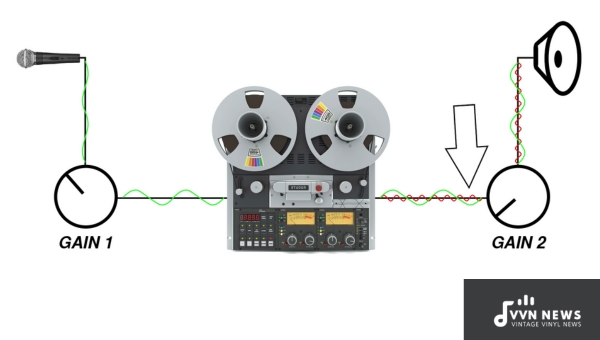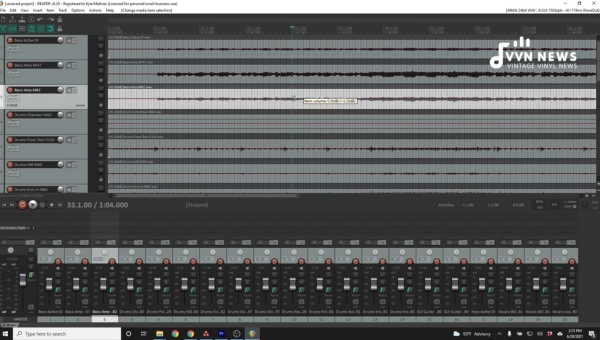In the fast-paced, ever-evolving world of music production, I’ve found that one technical aspect consistently proves crucial in shaping my mixes: gain staging.
The importance of gain staging is frequently understated, tucked away in the annals of forgotten musical jargon, waiting for its due recognition.
It’s high time we lift the curtain and truly explore this vital element that can make or break the sound quality of any audio endeavor.
If you are finding your mixes muddy and confusing or struggling with pesky distortion that taints your otherwise pristine audio files, you just might be overlooking gain staging.
Allow me to shine a spotlight on this technique that’s all too often relegated to the shadows.
Comprehending and mastering gain staging can accord you a clarity and depth in your creations that has been elusive thus far.
What is Gain Staging?
Gain staging, in simple terms, refers to the process of managing levels at each point in the audio signal path.
This signal path could span from the initial recording stage all through to the final mix.
The objective of this meticulous procedure is to achieve balanced and crisp sound while preventing unwanted distortions or noise occurrences.
Managing these audio levels efficiently allows your audio signal to maintain its best possible resolution.
With proper gain staging, each piece of equipment or processor within your recording software will receive a strong signal, one that isn’t distorted or too weak.
It’s much like setting that just right temperature for your coffee – not too hot that it burns your tongue, not too lukewarm that it doesn’t warm you up; it has to be perfect! Mastering gain staging would give you this perfection in your sound mixes.
Analog Vs Digital Gain Staging

Whether we’re discussing analog or digital systems, the fundamental principles of gain staging remain the same.
Their implementation differs significantly based on the distinctive characteristics of both platforms.
Analog Gain Staging
With analog systems, it’s a balancing act between noise and distortion.
An excessively low signal level can invite unwanted noise while an excessively high level would introduce distortion into your mix.
The ideal range typically falls around 0dBVU, where you’re rewarded with a rich, warm saturation – characteristic ‘analog’ sound that producers often seek to replicate in the digital realm.
Digital Gain Staging
In stark contrast to its analog counterpart, digital systems operate in strict binary terms – a signal is either present or not.
There’s no ‘sweet spot’. Instead, you must ensure that your signal never exceeds 0dBFS (decibels full scale), beyond which lies the land of irreparable distortion.
As a rule of thumb in digital gain staging, strive to maintain peaks at roughly -18dBFS for optimal system performance without causing clipping.
This headroom leaves enough space for upcoming additions and effects during mixing stages.
Understanding these distinctions forms the bedrock upon which you can build your mastery of gain staging terrain.
Regardless of whether you’re tinkering with vintage soundboards or modern DAWs (Digital Audio Workstation), effective gain staging ensures consistency across various hardware and plugins for perfectly leveled mixes every time.
Also Read: Mixing Bass And Kick For Low-end Balance [Expert Guide]
The Significance of Gain Staging in Audio Production
Understanding each phase of audio production is crucial to establishing an impeccable final mix.
Of these, gain staging plays a central part and has significant implications for various aspects.
Three such areas where gain staging has manifest consequent influence are the preservation of headroom, signal to plugins, and A/B testing effects and processing.
Preserving Headroom
An indispensable aspect of audio production is the delicate preservation of headroom.
Headroom refers to the difference between the typical level of your audio signals and the maximum level before the onset of distortion, known as clipping.
When you properly stage your gains, maintaining an adequate amount of headroom becomes an almost effortless task.
This, in turn, prevents unwanted distortions or saturated sounds in your mix which can hamper sound clarity and crispness.
Moreover, if you foresee subsequent stages where heavy processing may take place (such as mastering), having extra headroom can be a lifesaver.
It provides space for those adjustments without risk or compromise on sound purity.
Signal To Plugins
The next part where gain staging displays its importance is signal strength to plugins.
Every plugin within your DAW (Digital Audio Workstation) operates most effectively within certain defined levels.
If the signal input is too robust – it may overload your plugin leading to undesired distortion or saturation effects; too weak a signal might fail to trigger certain components accurately.
Effective gain staging, then ensures that each plugin functions at peak performance thereby elevating overall output quality.
A/B Testing Effects And Processing
Gain staging also finds its relevance prominently during A/B testing effects and processing phases under audio production.
While adjusting settings or making alterations in your mix – it’s essential that any changes made should be indicative only of the effect you’re adding or processing being done rather than simply volume differences.
In simpler terms, we want to hear how our changes contribute musically rather than just getting tricked by louder sounds which are generally perceived as better due to psychoacoustic principles in our hearing mechanisms.
By keeping volumes consistent while switching between processed (‘B’) and unprocessed (‘A’) signals – one can make more accurate judgments about what those adjustments bring musically and tonally to the composition; making gain staging pivotal here.
Preserving Headroom, Signal To Plugins, A/B Testing Effects And Processing are not only key components involved during gain staging but also vital reasons defining why understanding this understated process can significantly enhance quality output and make every audio track you lay down – a masterpiece!
Fundamental Parameters in Gain Staging

Efficient gain staging is a laborious process involving several critical variables, each contributing significantly to the final, harmonious audio mix.
Understanding these fundamental parameters is akin to viewing the blueprint of a building before construction; it paves the way for an efficient and effective work method.
I’ll focus on three crucial aspects: master bus output, limited bus or track output adjustments, and plugin modeling of analog hardware.
Output level of the Master Bus
The output level of your master bus plays an essential role in shaping your mix. It is recommended to ensure that the output of your master bus doesn’t exceed 0 dBFS.
This essentially serves as your upper limit as any signals above this threshold would inevitably induce distortion into your mix.
While working on your mixes or masters, aim to keep your peak levels around -6dBFS to -3dBFS at most. This gives you enough headroom and keeps you safely clear from digital clipping.
Adjustment in Output from Limited Bus or Track
Though it might seem logical in some scenarios to scale down the output from an already limited bus or track if it’s too loud, remember that it will still sound limited.
Adjusting the volume after limiting means that regardless of how much you bring down the total volume level of a peaking track, that peak reduction will remain constant because limiting has already occurred.
This parameter emphasizes understanding signal flow in your DAW (Digital Audio Workstation), essentially prompting plugins to process inputs rather than adjusting faders post-process.
Also Read: Guitar Amp Mic Mixing [Guide To Creating The Perfect Sound]
Plugins Modeling Analog Hardware
Many producers love using plugins emulating analog gear for their unique warmth and musicality.
However, weird as it might sound: “Some plug-ins model analog hardware—to a fault!” It means they can still distort like their hardware counterparts when hit with signals too hot!
For optimal performance, many such plugins require operating around an average level (VU) between -18dBFS and -12dBFS, akin to vintage gear’s ‘sweet zone’.
Pushing levels higher risks adding unwanted coloration or distortion; thus, keeping them within this safe range ensures they deliver their intended sonic characteristics without adverse effects.
It’s worth noting that these guidelines are not hard and fast rules, but general practices that can help eliminate common issues.
Each mix is unique– don’t be afraid to deviate from these norms as per your creative intuition.
Efficient gain staging invites you to be in constant conversation with your mix at every level and phase.
It’s about achieving an ideal balance where each component can interact harmoniously within the boundaries of your sonic canvas without unnecessary conflict or noise.
Once armed with an understanding and application of these fundamental guidelines, you will master how to unveil clean, clear, and radiant mixes every time.
Also Read: Can We Mix Bass In Stereo? 2025 [Mixing The Kick Drum & Bass]
How Gain Staging Enhances Your Mix?
Gain staging plays a pivotal role not only in producing outstanding sound quality but also in maintaining the integrity and depth of your mix.
Below, I explore how mastering gain staging can truly shift the dynamics of your musical journey.
Mastering
In the mastering stage, gain staging helps retain a level of consistency in sound volume across different tracks in an album or a project.
Precise gain staging ensures that every track stands on its own merit, without one overpowering the other. Consistent volume levels across tracks make for a smooth, immersive listening experience.
Ultimately, the goal during mastering is achieving coherence. Subpar gain staging could lead to jarring transitions or unequal loudness levels between tracks – breaking that sought-after flow in your melody.
Sends and Returns
When it comes to sends and returns, incorrect use may result in phasing issues, distorted sounds or even total silence.
Efficiently executed gain staging can help you dodge these unwanted intrusions with relative ease.
It’s vital to ensure that both incoming and outgoing audio signals are matching in their levels when using sends and returns to keep any gimmicky anomalies at bay.
Check Your Plugins
Plugins are like wildcards; they can really shake things up inside your mix- sometimes unexpectedly so!
Make sure to check each plugin’s input and output to prevent them from clipping or distorting the signal within.
Be cautious not to let normalization fool you into believing your levels are correct when they might not be.
Plugin compatibility is crucial too when it comes to maintaining clean signals throughout your audio path.
Use plugins that support your workflow so they don’t serve as hurdles in your audio production journey.
Noise Floor
Next up is our noise floor control; a significant battleground for those striving towards squeaky-clean audio production.
Setting gain too high brings us uncomfortably close to this noise floor – giving birth to buzzes and hums we’d rather avoid.
Gain staging aids us in steering clear of these extraneous sounds by helping maintain optimal gain across every equipment piece or processor down our signal chain – effectively keeping that dreaded noise floor at arm’s length!
Avoid Clipping
Perhaps one of the most accomplished achievements through successful gain staging is avoiding clipping.
Clipping occurs when an amplifier can no longer provide enough power supply voltage to follow the increased input signal’s peak voltages most commonly causing distortion.
When done right, gain staging should keep us away from crossing over the clip threshold by effectively controlling input levels, thus helping preserve audio clarity throughout our signal chain.
In closing, properly managing your signal at each stage along the way gives you optimal control over every sonic detail within your audio project – rendering phenomenal results.
Begin practicing due diligence with regard to setting appropriate levels across all stages during production and swiftly watch improvements unfurl within your mixes.
Steps for Effective Gain Staging

Properly executed gain staging can significantly improve your mixes, making them more professional and more pleasing to listen to.
Without further ado, let’s dive into the main steps to level-up your gain staging skills.
Tracking Device Signals
Just as a strong foundation is pivotal for a sturdy building, correctly tracking device signals is essential for flawless production.
Make sure that the audio signal entering your DAW (Digital Audio Workstation) isn’t too high nor too low. Aim for peak levels around -18dBFS (decibels full scale) on each individual track.
The primary rule here: the signal should be loud enough to be distinguished from any potential noise, yet not so intense it causes clipping or distortion.
Balancing Device Levels
Throughout the signal chain, various devices can amplify or diminish your audio signal levels.
For instance, your preamplifier and analog-to-digital converter (ADC) play crucial roles in securing optimal levels before conversion into digital form.
My advice: Continually check and adjust the gain settings on these devices to maintain balance along the entire chain.
Reduce Source Audio
There are times when one might want to capture loud sounds – like drums or electric guitars at full tilt – but these high-volume sources might cause peaking and unwanted distortions in your recording.
One practical strategy to prevent this scenario involves reducing the source’s audio output volume rather than just lowering gain on your interface—a significant step towards obtaining clean recordings while maintaining sufficient headroom.
Checking Track Volumes
Another key aspect of good gain staging lies in attentive monitoring of individual track volumes during mixing.
It’s critical that you aren’t fooled by sheer volume differences between tracks while working on a mixdown—a louder track can falsely appear better or more robust than it is in comparison with quieter ones.
Automating Gain
Consider exploring the feature-rich world of automatic gain control (AGC). AGC software comes in handy when looking to amplify quieter parts of an audio signal without risking distortion with louder parts.
As an intuitive technique able to mediate between too-soft and too-loud extremes, automated gain control presents itself as a worthwhile addition to your sound engineering toolbox—an investment you won’t regret.
Ultimately, mastering these steps arms you with the powerful ability to predict and control how each part of an audio production process impacts overall sound quality.
Also Read: How To Mix Vocals 2025 [guide]
FAQs About Gain Staging
What is gain staging in audio production?
Gain staging refers to the process of managing and optimizing the levels of audio signals in various stages of audio production – from recording to the final mix.
Why is gain staging important?
Gain staging prevents unwanted distortion and noise in your recordings. It ensures a clean, high-quality audio output by maintaining optimal signal levels throughout your audio chain.
Can improper gain staging hinder my mix quality?
Yes, improper gain staging can result in high noise levels, distortion or clipping, impacting the overall quality and clarity of your mixes.
How can I incorporate proper gain staging into my work process?
You need to ensure that each stage of your audio chain receives appropriate signal level – neither too weak nor too strong, monitor plugin inputs and outputs cautiously, perform systematic checks at every stage and maintain optimal headroom for best results.
Do analog and digital devices handle gain staging differently?
Yes indeed! In analog devices, higher levels often result in a form of pleasing distortion called saturation which is often undesired in digital devices as it leads to an unpleasant distortion known as clipping.
Conclusion
In audio production, navigating the barrage of controls and maintaining clarity can pose a challenge.
With a robust understanding of gain staging, an evolution in the quality of your mixes is inevitable.
This process ensures the right balance and amplifies the depth in your sound creations.
So, embrace gain staging and step into a world where every note resonates effectively, creating that perfectly harmonious symphony that doesn’t overstate or underplay.








